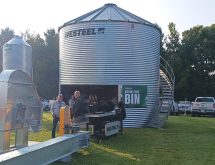Glacier FarmMedia – Why do some big bins survive winds of 150 km-h while nearby bins collapse or go sailing across the landscape? The problem has been made worse as bin size increases.
For many bin wrecks, the answer is pure chance. The wind decides what it will topple. However, design is a factor determining which bins sit tight and which bins take off.
All flat-bottomed bin designs must meet a rigid engineering code that is similar for American-built and Canadian-built units, “but there’s a certain amount of leeway in how a company interprets that code,” says Bruce Allen, retired engineering manager for Westeel.
Read Also

Clean seed garlic promises bigger bulbs and higher returns for growers
Ontario garlic trials show clean seed outshines conventional yields, with stronger drought resilience, reduced virus risk and greater economic outcomes.
He says there’s a significant difference in how manufacturers south of the border interpret the code compared to their Canadian counterparts. That interpretation makes the difference between bin survival and bin wreck.
Allen says the first sign that a bin is about to rip apart or fall is when the roof detaches from the walls. The design of the roof connection system is critical to bin survival, and that design system depends on the intended use of the bin.
“American farmers want an air gap between the bin wall and the roof. They do a lot more air drying in the bin than we do, so they need that gap for moist air to release. That intended use dictates how they mount the roof to the bin walls. So, the roof-mounting system is generally not as strong on American bins. The obvious result is it’s easier for wind to get under there and rip off the roof.
“It’s not a matter of cutting production costs, because they don’t save any money with an open-air connection. So, it is an area of concern. Canadian engineers go for more structural integrity in the roof connection.”
Canadian farmers who buy American-designed bins often find out too late that grain seeps out when the bin is full. Canadian-designed bins use roof rings to secure the roof to the walls. The roof is vital to the overall structural integrity. If it goes sailing, it’s a certainty the bin will topple. Some American manufacturers only have clips that hold the wall to the roof.
The wind ring pipes installed on most big bins play a big role in deflecting shear-force and plow-force winds. Steel at the top is thin and does not have a lot of survival strength. Once the bin bends out of round, it can get a big deep punch in the side, like a giant fist has hit it.
That can lead to the roof falling off or the bin falling over, or the bin remains standing but has a great big deep smile at the top of the wall.
To prevent this, wind ring pipes are fastened to the vertical stabilizers, where they help keep the bin perfectly 360-degrees round. In some cases, the roof ring does a good job of protecting the bin even if the punch dent is deep. These bins can be rebuilt.
“They give you resistance to the wind and resistance to the snow. That’s what the hoops are designed to do. But placement of the pipe is critical. You don’t just bolt them up. You have to span the distance between the eve and the peak. By putting those pipes in the middle of the measurement, you effectively cut that span in half,” says Allen.
Bins with grain in them are better protected from wind but can still be damaged if they are not completely full. The resulting “eyebrow” dents can be repaired.
“As bins got bigger, the span got longer, and thicker steel was available if the farmer wanted it. The ribs got higher and that helped. We reached the point where the hoops were the most practical cost-effective solution. And it all became more location specific. Dealers are beginning to understand that.
“What has happened sometimes in the past is a dealer sold a standard bin into an area where wind loads were higher than the specifications allowed. Same with snow load. A dealer might sell a cheaper bin into a region with high snow loads,” Allen says.
“I think for the most part the industry has cleaned that up. It’s a good reason to keep your eyes open and only work with reputable dealers. Dealers today preach to gospel of good engineering.”
Without concrete and anchors that meet specifications, any kind of bin is at risk of failure, according to AGI engineer Rob Foth.
“The connection between the bin and concrete is the critical point. An inferior connection gives the bin permission to topple.”
He says manuals for all AGI bins give the maximum wind upward lift per anchor point. He emphasizes that cutting corners on anchors is a bad decision. It places all liability on the party who decided to ignore the specifications. This can have all sorts of legal and insurance implications relating to collateral damage and human injury.
“Check to ensure the anchors, nuts and especially washers meet the uplift criteria, especially the washers. Most anchors come with the correct washer, but not all of them.
“I inspected some wind-damaged bins near Lethbridge. Most of their bins were full of grain, so that held them down. But there were two empty bins. They were only two years old and built by the colony. The anchors themselves were intact in the concrete. But the washers were too small and too thin. They bent upward vertically. The wind lifted the bins off the pad by bending the washers and pulling the angle ring right over the washers.”
The manual gives maximum allowable wind uplift per linear foot, or per washer. The contractor should always look at the anchor manual to determine what those loads are, and what anchors should be installed, be it a conventional mechanical anchor or a chemical anchor.
Chemical anchors still require the holes to be drilled in the pad, but they’re slightly bigger in diameter than a hole for a mechanical anchor.
The installer pours a resin mixture down the hole and drops in the anchor. The chemical is like an epoxy that binds the anchor to the concrete. Foth says a mechanical anchor needs to be longer and heavier to match the strength of a smaller chemical anchor.
Some contractors pre-cast the anchors into place and then pour the pad. The challenge then is to drop the bottom anchor band on the anchors. However, success with this method requires perfect placement of the pre-installed anchors. Most contractors pour the concrete, then come back to install the bottom ring so holes are drilled exactly where they should be.
“One thing we’ve done to help stabilize bins is to change the orientation of the slotted anchor holes in the bottom ring. Previously, the elongated holes went around the circumference of the bin,” says Foth.
“A full bin swells slightly at the bottom. It tries to protrude outwards. But the elongated holes were facing 90 degrees in the wrong direction. So, we now have the slotted holes arranged like the spokes of a wagon wheel. As the bottom ring tries to expand outward, the elongated holes can accommodate that slight movement.
“If you think sub-standard washers were installed when the bin went up, it’s not out of the question to retrofit the washers on your anchors when the bin is empty. Source the correct washers for your bin and wind load, then go ahead and install them.”
– This article was originally published at The Western Producer.














